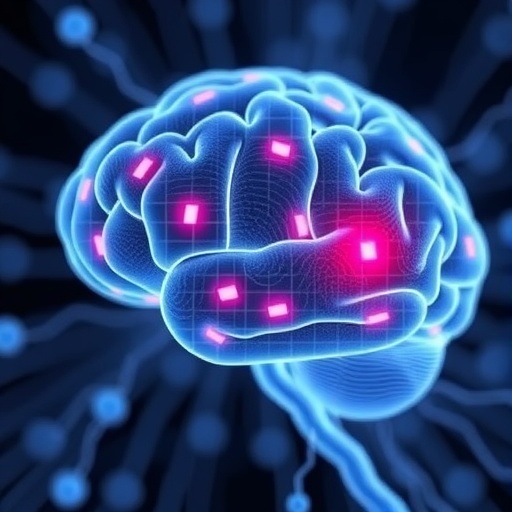In an unprecedented breakthrough in the field of brain-computer interfaces (BCIs) and neural implant systems, researchers have developed a novel type of electrode that significantly alters the landscape of bioelectronic interfaces. Traditional electrodes, once implanted within biological systems, tend to remain static and provide a limited scope of neural activity sampling. This limitation is exacerbated by the body’s immune responses, leading to signal degradation over time, or total device failure, which hampers the advancements in real-world applications of BCIs.
However, a dynamic shift is signaled by the introduction of a soft, movable, long-term implantable fiber electrode known as “NeuroWorm.” This innovation, spearheaded by a distinguished team from the Shenzhen Institute of Advanced Technology, features a design paradigm inspired by the earthworm’s flexible movement and segmented sensory capabilities. The NeuroWorm embodies the cutting-edge evolution of neural technology by transitioning from passive data acquisition to proactive exploration and interaction with brain and muscle tissues.
The design intricacies of NeuroWorm reflect years of research and technological advancements. By utilizing advanced electrode patterning techniques in combination with a novel rolling format, researchers have successfully converted a two-dimensional electrode array into a tiny fiber structure. This fiber measures approximately 200 micrometers in diameter, a scale that targets precision engineering while ensuring minimal invasiveness. The outcome is a miniaturized device that possesses the ability to integrate up to 60 independent signal channels along its entire length, creating a sophisticated sensory system capable of real-time data gathering.
One of the prime features of the NeuroWorm lies in the incorporation of a magnetic module at the tip, which allows for wireless steering via external magnetic fields. This ingenious mechanism enables researchers to navigate the NeuroWorm during its operation, allowing the device to actively traverse within the brain or along muscle layers as necessary. By doing so, it effectively captures high-quality spatiotemporal signals, thus facilitating in situ monitoring with unmatched versatility.
The research team rigorously validated the capabilities of NeuroWorm through their unique implantation technique in animal models. In an exemplary experiment, the NeuroWorm was implanted into a rat’s leg muscle through a minimally invasive incision measuring only half a centimeter. Utilizing external magnets, they could steer the NeuroWorm, guiding it dynamically across muscle surfaces while simultaneously capturing electromyographic (EMG) signals. Remarkably, X-ray imagery illustrated the smooth, bionic motion of the device, effectively demonstrating its ability to glide effortlessly between various tissue layers for a duration of seven days post-implantation.
Moreover, the researchers showcased NeuroWorm’s remarkable adaptability by implanting a single unit in a rat’s leg muscle for an extended period, exceeding 43 weeks. This timeframe allowed the device to consistently and stably record EMG signals without significant decline in performance. During the study, the fibrotic encapsulation around the NeuroWorm was quantitatively assessed, revealing a thickness of less than 23 micrometers—an impressive feat when compared to the 451 micrometers typically associated with conventional rigid electrodes. These dimensions not only emphasize the NeuroWorm’s minimally invasive nature but also underscore its superior biocompatibility.
In another impressive demonstration of the device’s capabilities, the researchers guided the NeuroWorm through a rabbit’s brain. From the cortex into the subcortical regions, the NeuroWorm successfully captured high-quality neural signals along its trajectory, underscoring both the practicality and versatility of its design. Such instances lend credence to the device’s long-term stability and ability to adapt to the complex biological environment where it operates.
The implications of this research extend beyond laboratory settings and towards real-world applications. The innovative design of NeuroWorm allows for noninvasive repositioning of implants through magnetic guidance, which could significantly reduce the need for surgeries necessitated by electrode drift or misplacement—a common occurrence with traditional rigid electrodes. This technology offers a promising avenue for long-term, multisite neural monitoring and suggests exciting potential applications in BCIs, smart prosthetics, epilepsy mapping, and the management of chronic neurological conditions.
Through the lens of technological evolution, NeuroWorm represents more than just a new implement; it embodies a significant leap towards a more intelligent and flexible neural interface. By fostering dynamic interaction with neural tissues and maintaining active monitoring capabilities, NeuroWorm is poised to enhance the quality of care for those relying on BCIs and related therapeutic interventions. As this groundbreaking research progresses, one can only anticipate the advancements that will emerge from the confluence of neuroscience and electronic engineering.
Continued exploration of NeuroWorm’s capabilities and potential applications is expected to pave the way for transforming not only medical interventions but also our understanding of brain and muscle dynamics. As researchers delve deeper into this promising technology, the possibilities for enhancing patient care in the domain of neurological disorders and assistive devices become increasingly tangible. The NeuroWorm is poised to foster a sophisticated landscape where technology and biology harmoniously intersect to revolutionize our interaction with the nervous system.
In conclusion, the NeuroWorm signifies a pivotal moment in neural technology, where flexibility, biocompatibility, and advanced operational capabilities merge to create a new frontier in bioelectronic interfaces. Future studies will undoubtedly expand upon these findings, further integrating these insights into broader applications aimed at improving the quality of life for individuals with neurological impairments. As we stand on the precipice of these innovations, the journey towards refining neurotechnological interventions is just beginning.
Subject of Research: Movable long-term implantable fiber electrodes and their applications in brain-computer interfaces and neural monitoring.
Article Title: A movable long-term implantable soft microfibre for dynamic bioelectronics
News Publication Date: 17-Sep-2025
Web References: http://dx.doi.org/10.1038/s41586-025-0934-w
References: Nature Journal
Image Credits: Not specified
Keywords
Electrodes, Brain-computer interfaces, Neural implants, Biocompatibility, Electromyographic signals, Dynamic monitoring, Soft electronics, Neuroprosthetics, Chronic neurological disorders.
Tags: advanced electrode patterning techniquesbioelectronic interface advancementsbrain-computer interfacesdynamic soft electrode technologyearthworm-inspired electrode designflexible neural implantslong-term implantable electrodesneural activity sampling improvementsNeuroWorm innovationproactive neural exploration technologyShenzhen Institute of Advanced Technology researchsignal degradation in BCIs





